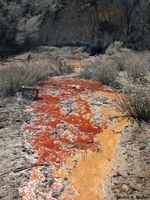WP 3: Human Influence on Metal Cycling
Humans influence the Earth’s weathering engine in various ways. Land-use has changed soil dynamics in agricultural landscapes and huge amounts of metal pollutants are continuously released into the environment by industrial and domestic activities. In other places, metal deficiency in soils is observed. These modifications affect the nutrient status of soils and freshwater. In this WP, we will determine and use the distinct isotope fingerprint of these anthropogenic influences on the environment that can be used to assess the efficacy of mitigation measures. Such insights could lead the way to new and novel methods of recovering economic metals from polluted waters and soils for further use by society. Importantly, these signals can be identified once their “natural background” has been understood in WP1 and WP2. The results from this WP will unlock the potential for using novel stable isotopes as environmental tracers (e.g. find pollution sources) and as tools to design strategies for environmental protection. The results from WP4 on the isotopic fingerprints of ore formation will help to guide research in this WP on the complementary process, the destruction of these resources and the subsequent release of metals to the environment.
WP Leaders
Balz Kamber, Trinity College Dublin
Jérôme Gaillardet, Institut de physique du globe de Paris



